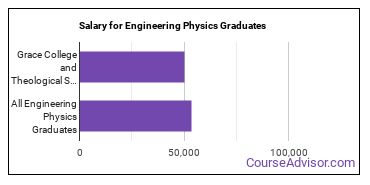Engineering Physics at Grace College and Theological Seminary
What traits are you looking for in a engineering physics school? To help you decide if Grace College and Theological Seminary is right for you, we've gathered the following information about the school's engineering physics program.Grace College is located in Winona Lake, Indiana and has a total student population of 1,901.
Want to know more about the career opportunities in this field? Check out the Careers in Engineering Physics section at the bottom of this page.
Featured schools near , edit
Grace College Engineering Physics Degrees Available
Grace College Engineering Physics Rankings
Note: Rankings don't always give a complete picture of a school's strengths and weaknesses, so it's a good idea to extend your research and also look at other factors when trying to decide if the school is right for you.
How Much Do Engineering Physics Graduates from Grace College Make?
The median salary of engineering physics students who receive their bachelor's degree at Grace College is $50,159. This is less than $53,359, which is the national average of all engineering physics majors in the nation who earn bachelor's degrees.

Grace College also has a doctoral program available in engineering physics. In 2021, 0 student graduated with a doctor's degree in this field.
Related Majors
Careers That Engineering Physics Grads May Go Into
A degree in engineering physics can lead to the following careers. Since job numbers and average salaries can vary by geographic location, we have only included the numbers for IN, the home state for Grace College and Theological Seminary.
| Occupation | Jobs in IN | Average Salary in IN |
|---|---|---|
| Architectural and Engineering Managers | 4,120 | $123,180 |
| Engineers | 2,380 | $73,340 |
| Natural Sciences Managers | 1,720 | $65,270 |
References
*The racial-ethnic minorities count is calculated by taking the total number of students and subtracting white students, international students, and students whose race/ethnicity was unknown. This number is then divided by the total number of students at the school to obtain the racial-ethnic minorities percentage.
More about our data sources and methodologies.
Featured Schools
 Request Info
Request Info
|
Southern New Hampshire University You have goals. Southern New Hampshire University can help you get there. Whether you need a bachelor's degree to get into a career or want a master's degree to move up in your current career, SNHU has an online program for you. Find your degree from over 200 online programs. Learn More > |
